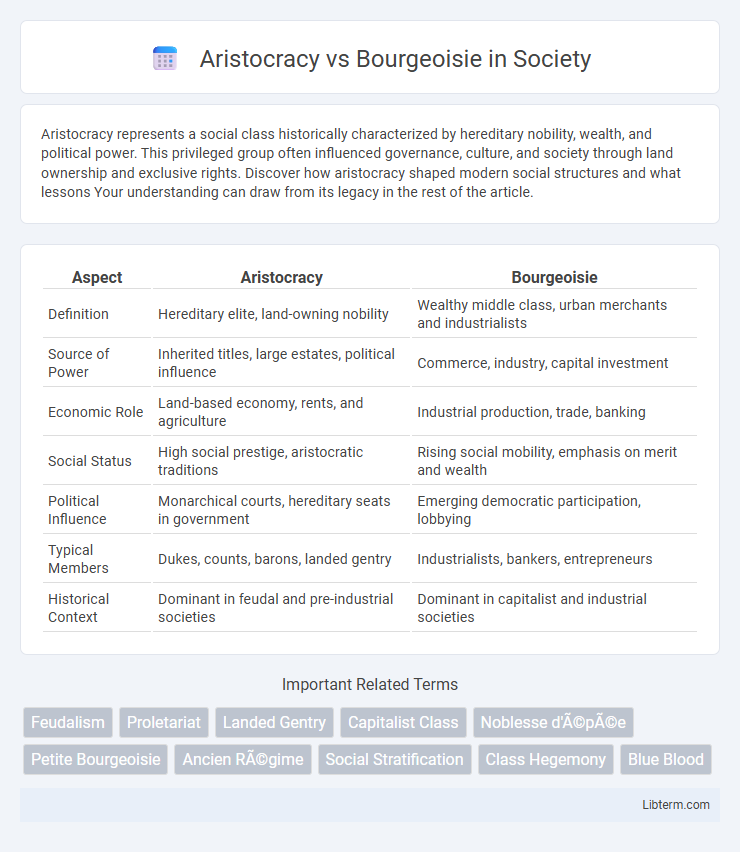Aristocracy represents a social class historically characterized by hereditary nobility, wealth, and political power. This privileged group often influenced governance, culture, and society through land ownership and exclusive rights. Discover how aristocracy shaped modern social structures and what lessons Your understanding can draw from its legacy in the rest of the article.
Table of Comparison
| Aspect | Aristocracy | Bourgeoisie |
|---|---|---|
| Definition | Hereditary elite, land-owning nobility | Wealthy middle class, urban merchants and industrialists |
| Source of Power | Inherited titles, large estates, political influence | Commerce, industry, capital investment |
| Economic Role | Land-based economy, rents, and agriculture | Industrial production, trade, banking |
| Social Status | High social prestige, aristocratic traditions | Rising social mobility, emphasis on merit and wealth |
| Political Influence | Monarchical courts, hereditary seats in government | Emerging democratic participation, lobbying |
| Typical Members | Dukes, counts, barons, landed gentry | Industrialists, bankers, entrepreneurs |
| Historical Context | Dominant in feudal and pre-industrial societies | Dominant in capitalist and industrial societies |
Origins and Historical Context of Aristocracy and Bourgeoisie
The aristocracy originated in feudal societies as a hereditary class of landowners and nobles, holding political power and social privileges since medieval Europe. The bourgeoisie emerged during the late Middle Ages and Renaissance as a capitalist class of merchants, industrialists, and professionals, gaining economic influence through trade and commerce in growing urban centers. This shift marked the gradual decline of feudal structures and the rise of capitalist economies, setting the stage for modern class dynamics.
Defining the Aristocracy: Lineage, Privilege, and Power
The aristocracy is defined by hereditary lineage, where noble birth grants enduring social status and exclusive privileges. This class wields significant political power, often owning vast estates and controlling key institutions. Their influence is maintained through tradition, legal rights, and a network of familial alliances.
Rise of the Bourgeoisie: Wealth, Commerce, and Influence
The rise of the bourgeoisie transformed social and economic landscapes by shifting wealth from hereditary aristocracy to commercial enterprise and industrial capital. Expanding trade networks, urbanization, and investment in manufacturing empowered the bourgeoisie with unprecedented economic influence and political leverage. Their accumulation of capital challenged traditional feudal power structures, laying foundations for modern capitalist societies.
Social Structures: Distinctions and Overlaps
Aristocracy and bourgeoisie represent distinct social classes defined by inherited privilege and wealth derived from commerce, respectively, shaping hierarchical social structures. Aristocrats traditionally hold titles and land, emphasizing lineage and political power, while the bourgeoisie accumulates economic influence through industry and trade, promoting meritocratic values. Despite clear differences, overlaps occur as bourgeois families acquire aristocratic status through wealth, blurring class boundaries and influencing social mobility in modern societies.
Political Influence and Governance Styles
Aristocracy traditionally wields political influence through hereditary privileges and centralized authority, often maintaining power via monarchies or noble councils. In contrast, the bourgeoisie gains political influence through economic power and participation in representative institutions, promoting governance styles centered on capitalism and liberal democracy. These differing foundations result in aristocratic governance emphasizing hierarchy and tradition, while bourgeoisie-led systems prioritize meritocracy and individual rights.
Cultural Values and Lifestyles Compared
Aristocracy traditionally values heritage, lineage, and exclusivity, with lifestyles centered around inherited wealth, formal social rituals, and patronage of the arts. Bourgeoisie emphasizes meritocracy, economic success, and individual achievement, often adopting more practical and consumption-oriented cultural practices such as entrepreneurship and investment in education. These differing cultural values influence social behaviors, with aristocrats favoring preservation of status quo and bourgeoisie promoting social mobility and innovation.
Economic Foundations: Landed Wealth vs. Capital Accumulation
The aristocracy's economic power historically stems from landed wealth, owning vast estates that generate income through agriculture and rents, ensuring long-term stability and social prestige. In contrast, the bourgeoisie derives wealth from capital accumulation, investing in commerce, industry, and finance, enabling rapid economic growth and adaptability. This fundamental difference influences social structures, with aristocrats emphasizing hereditary privilege and the bourgeoisie prioritizing entrepreneurial success and market-driven wealth.
Key Conflicts and Turning Points in Their Struggle
The key conflicts between aristocracy and bourgeoisie center around control of political power and economic influence, with aristocrats defending hereditary privileges while bourgeoisie championed meritocratic capitalism. Turning points include the decline of feudalism, the rise of the Industrial Revolution, and revolutions like the French Revolution which dismantled noble monopolies and empowered the commercial middle class. The resulting shifts led to modern nation-states where bourgeois values of entrepreneurship and legal equality increasingly shaped governance and social structures.
Aristocracy and Bourgeoisie in Modern Society
Aristocracy in modern society often retains influence through heritage, wealth, and exclusive social networks, maintaining traditional power structures despite diminished political control. Bourgeoisie, as the middle and upper-middle class, drives economic growth and cultural shifts through entrepreneurship, professional careers, and consumerism. The interplay between aristocratic legacy and bourgeoisie capital shapes contemporary social stratification and economic dynamics.
Legacy and Continuing Evolution of Class Dynamics
The aristocracy's legacy is deeply rooted in hereditary privilege, vast land ownership, and longstanding political influence, shaping societal hierarchies for centuries. The bourgeoisie emerged through industrialization and capitalism, leveraging economic power, entrepreneurship, and urbanization to challenge traditional class structures. Contemporary class dynamics continue to evolve as wealth accumulation, cultural capital, and technological access redefine social status and influence beyond hereditary lineage.
Aristocracy Infographic

 libterm.com
libterm.com